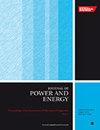Investigation on novel natural gas fueled homogeneous charge compression ignition engine based combined power and cooling system
IF 1.1
4区 工程技术
Q3 ENGINEERING, MECHANICAL
Proceedings of the Institution of Mechanical Engineers, Part A: Journal of Power and Energy
Pub Date : 2023-07-10
DOI:10.1177/09576509231188812
引用次数: 0
Abstract
A significant part of energy of fuel supplied is lost in internal combustion engines in the form of atmospheric discharge of engine exhaust gases which are considered as a big source of engine inefficiency and formation of pollutant emissions. To address this issue, a bottoming cycle combining the transcritical CO2 (T-CO2) refrigeration cycle and the supercritical CO2 (sCO2) power cycle is employed, aiming to produce cooling for food preservation by utilizing the exhaust heat of homogeneous charge compression ignition (HCCI) engine powering the refrigerated truck. The operative variables and their effect on thermal and exergetic efficiency of HCCI engine and the combined system are investigated. At the base case operative conditions, the thermal and exergy efficiencies of natural gas fueled HCCI engine are improved significantly from 48.69% to 61.28% and from 41.14% to 42.79%, respectively, after employing the sCO2 powered T-CO2 refrigeration cycle. Promotion of equivalence ratio from 0.3 to 0.9 enhances the thermal and exergy efficiencies of HCCI engine from 47.44% to 49.54% and from 40.14% to 42.12%, respectively. Increasing of engine speed from 1400 r.p.m to 2200 r.p.m provides marginal improvement in HCCI engine efficiencies but the efficiencies of combined cycle are significantly improved from 57.67% to 65.18% and from 40.64% to 45.06%, respectively. Finally, exergy analysis applied to determine the sources of non-idealities within the system revealed that out 361 kW (100%) fuel exergy supplied to the system, HCCI engine destroys 93.31 kW (25.85%), catalytic convertor destroys15.49 kW (4.29%), and the in-cylinder heat transfer losses and system exhaust losses are found as 35.72 kW (9.91%) and 16.61 kW (4.61%), respectively.基于动力与冷却联合系统的新型天然气均装压缩点火发动机研究
燃料供给的很大一部分能量在内燃机中以发动机废气的形式排放到大气中,这被认为是发动机效率低下和污染物排放形成的一个重要来源。为了解决这一问题,采用了跨临界CO2 (T-CO2)制冷循环和超临界CO2 (sCO2)动力循环相结合的底循环,旨在利用均质装药压缩点火(HCCI)发动机的余热为冷藏车提供动力,为食品保鲜提供冷却。研究了HCCI发动机及其组合系统的工作参数及其对热效率和火用效率的影响。在基本工况条件下,采用sCO2驱动的T-CO2制冷循环后,天然气燃料HCCI发动机的热效率和火用效率分别从48.69%提高到61.28%和41.14%提高到42.79%。当当量比由0.3提高到0.9时,HCCI发动机热效率和火用效率分别由47.44%和40.14%提高到49.54%和42.12%。将发动机转速从1400转/分提高到2200转/分,HCCI发动机效率略有提高,但联合循环效率分别从57.67%提高到65.18%和40.64%提高到45.06%。最后,通过火用分析确定系统内非理想源,结果表明,在提供给系统的361 kW(100%)燃料火用中,HCCI发动机消耗93.31 kW(25.85%),催化转化器消耗15.49 kW(4.29%),缸内传热损失35.72 kW(9.91%),系统排气损失16.61 kW(4.61%)。
本文章由计算机程序翻译,如有差异,请以英文原文为准。
求助全文
约1分钟内获得全文
求助全文
来源期刊

CiteScore
3.30
自引率
5.90%
发文量
114
审稿时长
5.4 months
期刊介绍:
The Journal of Power and Energy, Part A of the Proceedings of the Institution of Mechanical Engineers, is dedicated to publishing peer-reviewed papers of high scientific quality on all aspects of the technology of energy conversion systems.
 求助内容:
求助内容: 应助结果提醒方式:
应助结果提醒方式:


